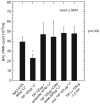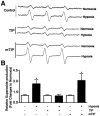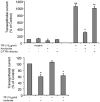The lectin-like domain of tumor necrosis factor improves lung function after rat lung transplantation--potential role for a reduction in reactive oxygen species generation
- PMID: 20081530
- PMCID: PMC4903871
- DOI: 10.1097/CCM.0b013e3181cdf725
The lectin-like domain of tumor necrosis factor improves lung function after rat lung transplantation--potential role for a reduction in reactive oxygen species generation
Abstract
Objective: To test the hypothesis that the lectin-like domain of tumor necrosis factor, mimicked by the TIP peptide, can improve lung function after unilateral orthotopic lung isotransplantation. Because of a lack of a specific treatment for ischemia reperfusion-mediated lung injury, accompanied by a disrupted barrier integrity and a dysfunctional alveolar liquid clearance, alternative therapies restoring these parameters after lung transplantation are required.
Design: Prospective, randomized laboratory investigation.
Setting: University-affiliated laboratory.
Subjects: Adult female rats.
Interventions: Tuberoinfundibular peptide, mimicking the lectin-like domain of tumor necrosis factor, mutant TIP peptide, N,N'-diacetylchitobiose/TIP peptide, and amiloride/TIP peptide were instilled intratracheally in the left lung immediately before the isotransplantation was performed. An additional group received an intravenous TIP peptide treatment, 1.5 mins before transplantation. Studies using isolated rat type II alveolar epithelial cell monolayers and ovine pulmonary endothelial cells were also performed.
Measurements and main results: Intratracheal pretreatment of the transplantable left lung with the TIP peptide, but not with an inactive mutant TIP peptide, resulted in significantly improved oxygenation 24 hrs after transplantation. This treatment led to a significantly reduced neutrophil content in the lavage fluid. Both the effects on oxygenation and neutrophil infiltration were inhibited by the epithelial sodium channel blocker amiloride. The TIP peptide blunted reactive oxygen species production in pulmonary artery endothelial cells under hypoxia and reoxygenation and reduced reactive oxygen species content in the transplanted rat lungs in vivo. Ussing chamber experiments using monolayers of primary type II rat pneumocytes indicated that the primary site of action of the peptide was on the apical side of these cells.
Conclusions: These data demonstrate that the TIP peptide significantly improves lung function after lung transplantation in the rat, in part, by reducing neutrophil content and reactive oxygen species generation. These studies suggest that the TIP peptide is a potential therapeutic agent against the ischemia reperfusion injury associated with lung transplantation.
Figures





Comment in
-
Dr. Jekyll and Mr. Hyde saga of a cytokine: the devil in the details.Crit Care Med. 2010 Mar;38(3):997-8. doi: 10.1097/CCM.0b013e3181ce2070. Crit Care Med. 2010. PMID: 20168164 No abstract available.
Similar articles
-
The lectin-like domain of tumor necrosis factor-alpha improves alveolar fluid balance in injured isolated rabbit lungs.Crit Care Med. 2008 May;36(5):1543-50. doi: 10.1097/CCM.0b013e31816f485e. Crit Care Med. 2008. PMID: 18434905
-
AP301, a synthetic peptide mimicking the lectin-like domain of TNF, enhances amiloride-sensitive Na(+) current in primary dog, pig and rat alveolar type II cells.Pulm Pharmacol Ther. 2013 Jun;26(3):356-63. doi: 10.1016/j.pupt.2012.12.011. Epub 2013 Jan 9. Pulm Pharmacol Ther. 2013. PMID: 23313096 Free PMC article.
-
Lasting beneficial effect of short-term inhaled nitric oxide on graft function after lung transplantation. Paris-Sud University Lung Transplantation Group.J Thorac Cardiovasc Surg. 1996 Sep;112(3):590-8. doi: 10.1016/s0022-5223(96)70040-5. J Thorac Cardiovasc Surg. 1996. PMID: 8800144
-
Dichotomous Role of Tumor Necrosis Factor in Pulmonary Barrier Function and Alveolar Fluid Clearance.Front Physiol. 2022 Feb 21;12:793251. doi: 10.3389/fphys.2021.793251. eCollection 2021. Front Physiol. 2022. PMID: 35264975 Free PMC article. Review.
-
Dynamics of pulmonary endothelial barrier function in acute inflammation: mechanisms and therapeutic perspectives.Cell Tissue Res. 2014 Mar;355(3):657-73. doi: 10.1007/s00441-014-1821-0. Epub 2014 Mar 6. Cell Tissue Res. 2014. PMID: 24599335 Free PMC article. Review.
Cited by
-
Inhalation therapy with the synthetic TIP-like peptide AP318 attenuates pulmonary inflammation in a porcine sepsis model.BMC Pulm Med. 2015 Feb 7;15:7. doi: 10.1186/s12890-015-0002-6. BMC Pulm Med. 2015. PMID: 25879802 Free PMC article.
-
The Acute Respiratory Distress Syndrome: Mechanisms and Perspective Therapeutic Approaches.Austin J Vasc Med. 2015 Jun 4;2(1):1009. Austin J Vasc Med. 2015. PMID: 26973981 Free PMC article.
-
Mini-review: novel therapeutic strategies to blunt actions of pneumolysin in the lungs.Toxins (Basel). 2013 Jul 15;5(7):1244-60. doi: 10.3390/toxins5071244. Toxins (Basel). 2013. PMID: 23860351 Free PMC article. Review.
-
Ex Vivo Pulmonary Oedema after In Vivo Blast-Induced Rat Lung Injury: Time Dependency, Blast Intensity and Beta-2 Adrenergic Receptor Role.Biomedicines. 2022 Nov 15;10(11):2930. doi: 10.3390/biomedicines10112930. Biomedicines. 2022. PMID: 36428498 Free PMC article.
-
Essential structural features of TNF-α lectin-like domain derived peptides for activation of amiloride-sensitive sodium current in A549 cells.J Med Chem. 2010 Nov 25;53(22):8021-9. doi: 10.1021/jm100767p. Epub 2010 Oct 27. J Med Chem. 2010. PMID: 20979368 Free PMC article.
References
-
- Wiener-Kronish JP, Matthay MA. Beta-2-agonist treatment as a potential therapy for acute inhalational lung injury. Crit Care Med. 2006;34:1841–1842. - PubMed
-
- Su X, Robriquet L, Folkesson HG, et al. Protective effect of endogenous beta-adrenergic tone on lung fluid balance in acute bacterial pneumonia in mice. Am J Physiol Lung Cell Mol Physiol. 2006;290:L769–L776. - PubMed
Publication types
MeSH terms
Substances
Grants and funding
LinkOut - more resources
Full Text Sources
Other Literature Sources
Medical

